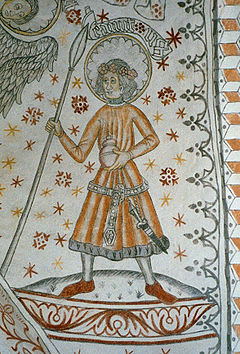Saint Knut's Day
| Saint Knut's Day | |
|---|---|
 Canute Lavard | |
| Also called | Tjugondag jul, Tjugondag Knut, Knutomasso |
| Observed by | Sweden, Finland, Estonia (future) |
| Date | 13 January |
| Next time | 13 January 2025 |
| Frequency | annual |
Tjugondag jul ("Twentieth Day Yule"), or Tjugondag Knut ("Twentieth Day Knut"), or Knutomasso,[1] in English Saint Knut's Day,[2] (Finnish: nuutinpäivä) is a traditional festival celebrated in Sweden and Finland on 13 January. It is not celebrated on this date in Denmark despite being named for the Danish prince Canute Lavard, and later also associated with his uncle, Canute the Saint, the patron saint of Denmark.[3][4][5] Christmas trees are taken down on Tjugondag jul, and the candies and cookies that decorated the tree are eaten. In Sweden, the feast held during this event is called a Christmas tree plundering (Julgransplundring).[6]
Origins
Canute Lavard (Knut Levard in Swedish) was a Danish duke who was assassinated by his cousin and rival Magnus Nilsson on 7 January 1131 so he could usurp the Danish throne.[7][8] In the aftermath of his death there was a civil war, which led to Knut being later declared a saint, and 7 January became Knut's Day, a name day.[3]
As his name day roughly coincided with Epiphany (the "thirteenth day of Christmas"), Knut's Day and Epiphany were conflated to some degree. In 1680, Knut's Day was moved to 13 January and became known as tjugondag Knut or tjugondedag jul (the "twentieth day of Knut/Christmas").[8]
Finland
On Nuutinpäivä, there has been a tradition somewhat analogous to modern Santa Claus, where young men dressed as a goat (Finnish: Nuuttipukki) would visit houses. Usually the dress was an inverted fur jacket, a leather or birch bark mask, and horns. Unlike Santa Claus, Nuuttipukki was a scary character (cf. Krampus). The men dressed as Nuuttipukki wandered from house to house, came in, and typically demanded food from the household and especially leftover alcoholic beverages. In Finland the Nuuttipukki tradition is still living at areas of Satakunta, Southwest Finland and Ostrobothnia. However, nowadays the character is usually played by children and now involves a happy encounter.[9]
Dialectical proverb from Noormarkku says: Hyvä Tuomas joulun tua, paha Knuuti poijes viä or "Good [St.] Thomas brings the Christmas, evil Knut takes [it] away."[10]
Sweden
In Sweden St. Knut's Day marks the end of the Christmas and holiday season and is celebrated with a plundering of the Christmas tree. In modern days, the feast is mainly for children.[6]
References
- ^ Karlsson, Kenneth. "Knut Photos". Knutmasso Museum. Retrieved 14 January 2016.
- ^ "St. Knut's Day definition of St. Knut's Day in the Free Online Encyclopedia". Encyclopedia2.thefreedictionary.com. Retrieved 13 January 2014.
- ^ a b "Tjugondag Knut". www.nordiskamuseet.se. Nordic Museum. Retrieved 10 January 2016.
{{cite web}}: Unknown parameter|trans_title=ignored (|trans-title=suggested) (help) - ^ Henrikson, Alf (2013). Svensk Historia (in Swedish). Albert Bonniers Förlag. ISBN 9100136565.
{{cite book}}: Unknown parameter|trans_title=ignored (|trans-title=suggested) (help) - ^ "Knut kör julen ut". www.firajul.nu. FiraJul. Retrieved 14 January 2016.
{{cite web}}: Unknown parameter|trans_title=ignored (|trans-title=suggested) (help) - ^ a b "Julgransplundring: Rocking around the Christmas Tree". Your Living City. 3 January 2014. Retrieved 10 January 2016.
- ^ Bricka, Carl Frederik (1897). Dansk Biografisk Lexikon. Vol. XI. Maar – Müllner. p. 45.
- ^ a b af Klintberg, Bengt (2001). Namnen i almanackan (in Swedish) (1 ed.). Stockholm: Norstedts ordbok. ISBN 91-7227-292-9. SELIBR 8372769.
{{cite book}}: Unknown parameter|trans_title=ignored (|trans-title=suggested) (help) - ^ "Satakunnan Kansa". Satakunnankansa.fi. 13 January 2011. Retrieved 13 January 2014.
- ^ "Nuuttipukin naamari". Nba.fi. 27 September 2012. Retrieved 13 January 2014.
